

Clinical judgments, not algorithms, are key to patient safety—an essay by David Healy and Dee Mangin. When it comes to detecting harms related to drugs, clinicians’ and patients’ judgment trumps trials, say David Healy and Dee Mangin.
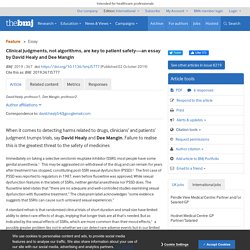
Failure to realise this is the greatest threat to the safety of medicines Immediately on taking a selective serotonin reuptake inhibitor (SSRI), most people have some genital anaesthesia.1 This may be aggravated on withdrawal of the drug and can remain for years after treatment has stopped, constituting post-SSRI sexual dysfunction (PSSD).2 The first case of PSSD was reported to regulators in 1987, even before fluoxetine was approved. While sexual dysfunction features in the labels of SSRIs, neither genital anaesthesia nor PSSD does. The fluoxetine label states that “there are no adequate and well-controlled studies examining sexual dysfunction with fluoxetine treatment.” The citalopram label acknowledges “some evidence suggests that SSRIs can cause such untoward sexual experiences.”
Time To Change The 15-Minute Limit For Doctor Visits. Some patients, such as Felipe Finale (pictured here), the man who received the world's smallest pacemaker, may get more than 15 minutes with his doctor.
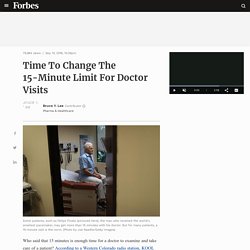
But for many patients, a 15-minute visit is the norm. (Photo by Joe Raedle/Getty Images) Who said that 15 minutes is enough time for a doctor to examine and take care of a patient? According to a Western Colorado radio station, KOOL 107.9 FM, this is roughly the same amount of time men spend on the toilet each day, which could increase depending on what you eat and how much toilet texting you do. From Sweden to Texas via the IHI National Forum: Do-It-Yourself Dialysis. My team thought I was crazy.
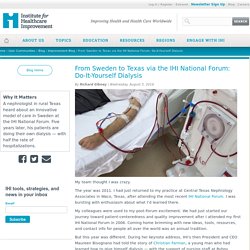
The year was 2011. Management of multimorbidity using a patient-centred care model: a pragmatic cluster-randomised trial of the 3D approach. - PubMed - NCBI. Extending the Applicability of Clinical Practice Guidelines to Patients with Multiple Chronic Conditions – Minimally Disruptive Medicine. This is a reprint of a previous publication held on guidelines.gov. We will work to update information within in coming blog posts. By: Aaron L. Leppin, MD and Victor M. Do Hospital Visitors Impact Patient Outcomes? By Brit Trogen Peer Reviewed In 2001, the Institute of Medicine’s Crossing the Quality Chasm became the seminal paper recognizing patient-centered care as a crucial component of overall health care quality.[1] Since then, patient and family centered care (PFCC) has been increasingly recognized as a valuable model for improving patient outcomes, facilitating communication, and increasing satisfaction with care.[2] Open and flexible visitation policies are a major component of many PFCC programs and have been widely embraced by hospitals throughout the US [3] However, the impact of family presence on patients and hospital staff is complex, with varying impacts on patients, family members, and hospital staff.
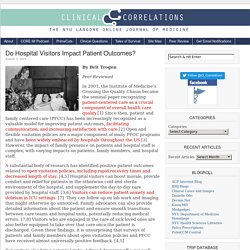
Association of Clinician Denial of Patient Requests With Patient Satisfaction. - PubMed - NCBI. Findings from a feasibility study to improve GP elicitation of patient concerns in UK general practice consultations - Patient Education and Counseling. Understanding What Is Most Important to Individuals with Multiple Chronic Conditions: A Qualitative Study of Patients' Perspectives. - PubMed - NCBI. Doctors, Revolt! But Dr.
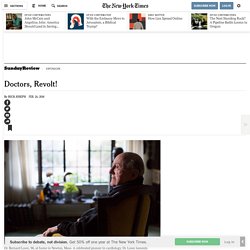
Lown identifies first and foremost as a healer. In 1996, he published “The Lost Art of Healing,” an appeal to restore the “3,000-year tradition, which bonded doctor and patient in a special affinity of trust.” The biomedical sciences had begun to dominate our conception of health care, and he warned that “healing is replaced with treating, caring is supplanted by managing, and the art of listening is taken over by technological procedures.”
He called for a return to the fundamentals of doctoring — listening to know the patient behind the symptoms; carefully touching the patient during the physical exam to communicate caring; using words that affirm the patient’s vitality; and attending to the stresses and situations of his life circumstances. This time he was the patient in need of healing. The art of conversation - The Lancet. The College of Family Physicians of Canada. How Design Thinking Is Improving Patient-Caregiver Conversations. Executive Summary Technical developments tend to grab the headlines in health care.
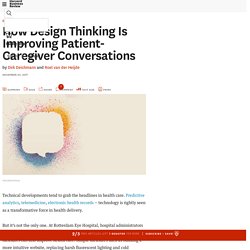
Predictive analytics, telemedicine, electronic health records — technology is rightly seen as a transformative force in health delivery. But it’s not the only one. At Rotterdam Eye Hospital, hospital administrators have found that through their ongoing design-thinking program, lower-tech measures can improve patient outcomes. Such simple measures as building a more intuitive website, replacing harsh fluorescent lighting and cold linoleum floors with softer lighting and wood parquet, and giving children and pediatric ophthalmologists matching T-shirts have all served to reduce patient fears. Technical developments tend to grab the headlines in health care. But it’s not the only one. Improving patient care using clinical guidelines and judgement.
Guidance to clinicians on patient care has increasingly become institutionalised through clinical practice guidelines (CPGs).
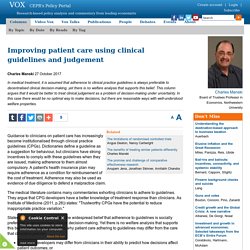
Dictionaries define a guideline as a suggestion for behaviour, but clinicians have strong incentives to comply with these guidelines when they are issued, making adherence to them almost compulsory. A patient's health insurance plan may require adherence as a condition for reimbursement of the cost of treatment. Adherence may also be used as evidence of due diligence to defend a malpractice claim.
The medical literature contains many commentaries exhorting clinicians to adhere to guidelines. Assessing the Burden of Treatment. The missing person: The outcome of the rule-based totalitarianism of too much contemporary healthcare - ScienceDirect. <div pearltreesdevid="PTD138" role="alert" class="alert-message-container"><div pearltreesdevid="PTD139" aria-hidden="true" class="alert-message-body"><span pearltreesdevid="PTD140" style="display: inline-block;" class="Icon IconAlert"><svg pearltreesDevId="PTD141" style="width: 100%; height: 100%;" width="24" height="24" focusable="false" tabindex="-1" fill="currentColor"><path pearltreesDevId="PTD142" fill="#f80" d="M11.84 4.63c-.77.05-1.42.6-1.74 1.27-1.95 3.38-3.9 6.75-5.85 10.13-.48.83-.24 1.99.53 2.56.7.6 1.66.36 2.5.41 3.63 0 7.27.01 10.9-.01 1.13-.07 2.04-1.28 1.76-2.39-.1-.58-.56-1.02-.81-1.55-1.85-3.21-3.69-6.43-5.55-9.64-.42-.52-1.06-.83-1.74-.79z"></path><path pearltreesDevId="PTD143" d="M11 8h2v5h-2zM11 14h2v2h-2z"></path></svg></span><!
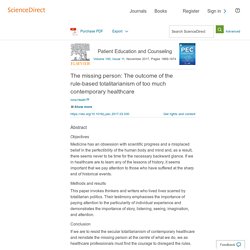
-- react-text: 58 -->JavaScript is disabled on your browser. Please enable JavaScript to use all the features on this page. <! -- /react-text --></div></div> Abstract Objectives Methods and results Conclusion Practice implications. Sharing control of appointment length with patients in general practice: a qualitative study. Familiarity breeds better outcomes. Let’s be clear: familiarity breeds better outcomes.

People who have a usual, continuous source of primary medical care generally do better than those who don’t. We know this, and yet everywhere primary care and general practice are in crisis. The United Kingdom is no exception. Its medical schools are “training future doctors for yesterday,” say our editorialists John Oldham and Sam Everington (doi:10.1136/bmj.j294). The Heroism of Incremental Care. By 2010, Bill Haynes had spent almost four decades under attack from the inside of his skull.
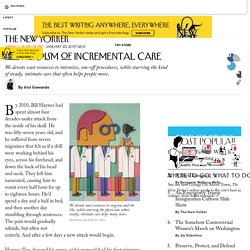
He was fifty-seven years old, and he suffered from severe migraines that felt as if a drill were working behind his eyes, across his forehead, and down the back of his head and neck. They left him nauseated, causing him to vomit every half hour for up to eighteen hours. He’d spend a day and a half in bed, and then another day stumbling through sentences. The pain would gradually subside, but often not entirely. Ask patients “What matters to you?” rather than “What’s the matter?”
Sosena Kebede, assistant professor of medicineAuthor affiliationsskebede3@jhmi.edu This can help reframe interactions in a more patient centered way Maureen Bisognano, one of the keynote speakers at this year’s International Forum on Quality and Safety in Healthcare in Gothenburg, Sweden, told delegates that we should ask our patients, “What matters to you?” Rather than, “What is the matter?” The Values and Value of Patient-Centered Care.
+ Author Affiliations CORRESPONDING AUTHOR: Ronald M. Epstein, MD, Center for Communication and Disparities Research, University of Rochester Medical Center, 1381 South Ave, Rochester, NY 14620, Ronald_Epstein@urmc.rochester.edu. Journal of Clinical Nursing Seeing the person behind the patient enhancing the care of older people using a biographical approach. “Nudge” in the clinical consultation – an acceptable form of medical paternalism? Can consumers learn to ask three questions to improve shared decision making? A feasibility study of the ASK (AskShareKnow) Patient–Clinician Communication Model® intervention in a primary health-care setting - Shepherd - 2015 - Health Expectations. Abstract Objective To test the feasibility and assess the uptake and acceptability of implementing a consumer questions programme, AskShareKnow, to encourage consumers to use the questions ‘1.
What are my options; 2. What are the possible benefits and harms of those options; 3. How likely are each of those benefits and harms to happen to me?’ Methods. The importance of being different (Family Practice) - McWhinney. Making EBM work for individual patients. Margaret McCartney, general practitioner1, Julian Treadwell, general practitioner2, Neal Maskrey, visiting professor3, Richard Lehman, senior advisory fellow in primary care4Author affiliationsCorrespondence to: M McCartney margaret@margaretmccartney.com Margaret McCartney and colleagues argue that new models of evidence synthesis and shared decision making are needed to accelerate a move from guideline driven care to individualised care A Google Scholar search using the term “evidence based medicine” identifies more than 1.8 million papers.
Over more than two decades, evidence based medicine has rightfully become part of the fabric of modern clinical practice and has contributed to many advances in healthcare. Guidelines grew out of a need to communicate best current evidence to clinicians, but their limitations are often not explicitly stated (box 1). How Person-Centered Is Your Health Care Organization? The movement to transform the country’s health care delivery system has been underway for several years now, and some moments of truth are approaching. Taking patient-centred health care from rhetoric to reality. Caring with evidence based medicine. Ian Hargraves, designer1, Marleen Kunneman, postdoctoral research fellow1 2, Juan P Brito, assistant professor of medicine1 3, Victor M Montori, professor of medicine1 3Author affiliationsCorrespondence to: V M Montori montori.victor@mayo.edu. Toward Preference-Sensitive Guidelines.
A survey of primary care patients' readiness to engage in the de-adoption practices recommended by Choosing Wisely Canada. Symptoms as the main problem: a cross- sectional study of patient experience in primary care. Strengths and limitations A major strength of this study was the large number of GPs and patients who agreed to participate.
However, substantial numbers of patients chose not to respond to the questionnaire. Consequently, the generalisability may be compromised for young people with fewer years of education and no chronic disease who live alone. As these are all factors which would potentially contribute to dissatisfaction, non-response would tend to bias our results towards lower frequencies and lower differences between patient groups. The setting (Denmark, Western Europe) itself is selected, and we do not know whether the results may apply to other primary-care settings. The study was strengthened by the linkage between GP registrations and patient questionnaires as this procedure ensured that patients could be linked to the individual GPs rather than to the practices.
GP diagnostics have shown large variability, especially for MUS [21]. Doctor Yearns For Return To Time When Physicians Were 'Artisans' “Informed choice” in a time of too much medicine—no panacea for ethical difficulties. Minna Johansson, PhD student1 2, Karsten Juhl Jørgensen, senior researcher3, Linn Getz, professor4, Ray Moynihan, senior research fellow5Author affiliationsCorrespondence to: M Johansson minna.johansson@vgregion.se. Making evidence based medicine work for individual patients.
What Do Physicians Tell Patients About Themselves? Iora Health pioneers new primary care model. BURLINGTON — A year ago, Jeffrey Davis had just about given up on going to the doctor. Origins - Medicine of the Person. "Medicine of the Person", or rather, "Médecine de la Personne" is the title of a book published in French in 1940, by Dr Paul Tournier, a general practitioner in Geneva. At a period when psychosomatic medicine was in its infancy, he was struck by the fact that the contemporary approach to illness was purely organic, and failed to consider the patient as a whole, with not only a physical dimension but psychological and spiritual dimensions as well.
He invited medical colleagues specialising in a variety of fields and also a number of philosophers to reflect on this with him and organised yearly meetings, which from 1947 onwards were attended by delegates from several countries and became known as "International Meetings of Medicine of the Person". The possibilities of patient-centered medicine. If Patients Only Knew How Often Treatments Could Harm Them. In the patient’s best interests? Who says? Fiona Godlee, editor in chief, The BMJfgodlee{at}bmj.com “For moral autonomy it is more important to make ‘wrong’ choices than to obey instructions,” writes Michael Fitzpatrick in this week’s Head to Head debate (doi:10.1136/bmj.h5654).
A ban on smoking in psychiatric hospitals would, he says, cause distress to patients and conflicts with staff. Empowering the elderly in Japan: lessons for home care in Canada. The Paternalism Preference — Choosing Unshared Decision Making. Ellipsis: Seeing My Way to "No" (Guest Blog by Alan Schroeder) Smuggling a Beer for My Hospital Patient - The New York Times. What is WrapAround? A challenge for new doctors: Focus on the patient, not just the symptoms. Observational study of effect of patient centredness and positive approach on outcomes of general practice consultations. Five Keys to 'Less Is More' Medicine in the Clinic.
Ten Commandments for patient-centred treatment. A Doctor's 'People Skills' Affects Patients' Health. The 6 questions every good doctor should ask you. Visit-specific expectations and patient-centered outcomes: a literature review. Harvard Studied People For 75 Years & Found That Happiness Comes From One Thing... A patient-initiated voluntary online survey of adverse medical events: the perspective of 696 injured patients and families.
Amy Price and Marilyn Mann on the pros of patient peer review. What If Everything You Knew About Disciplining Kids Was Wrong?